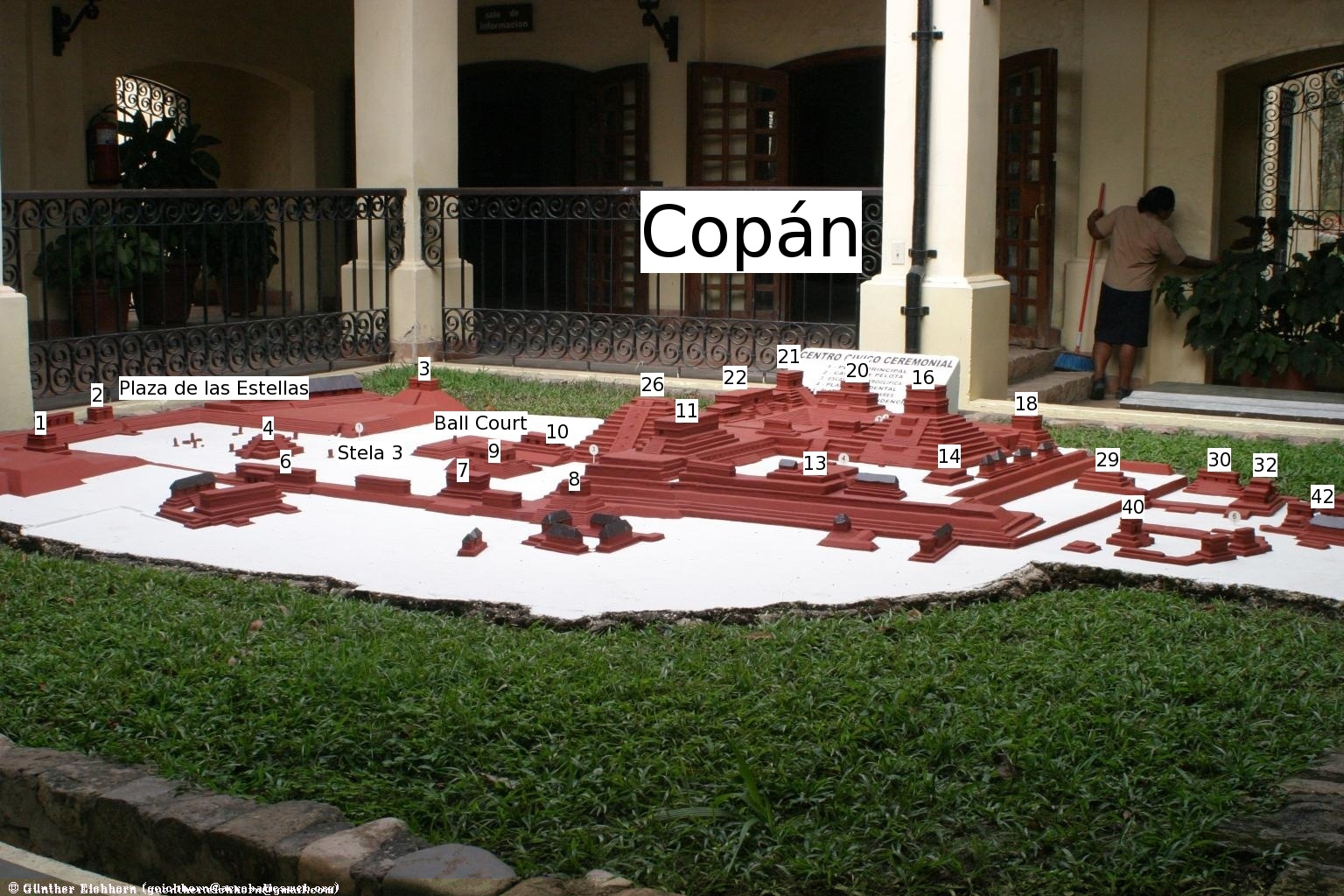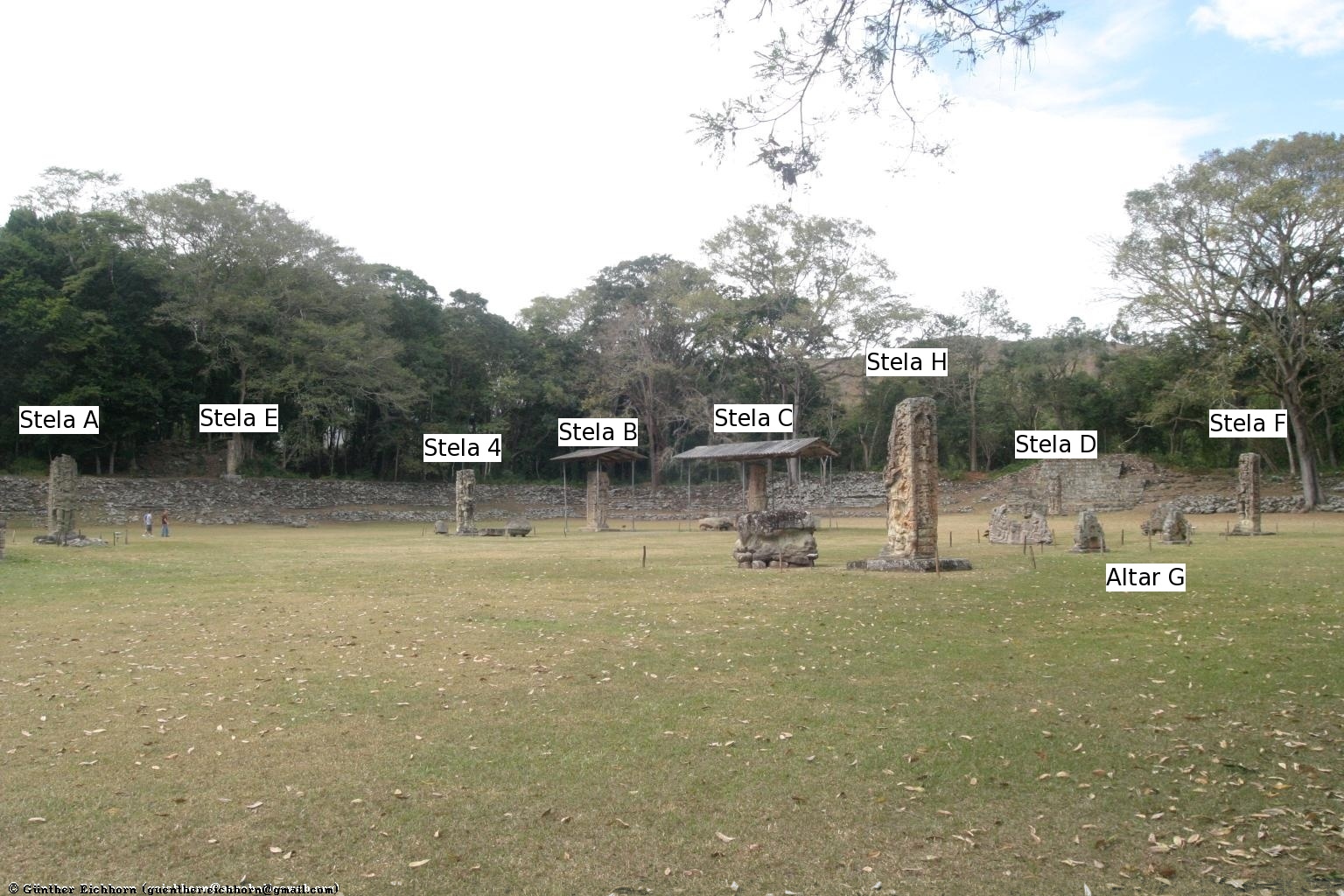
Copán is one of the three major Maya centers (besides Tikal in Guatemala and Chich'én Itzá in México). Maya Site of Copán is a UNESCO World Heritage Site. It was another fascinating remnant of Ancient Civilizations that I encountered during my travels.
Copán has more hieroglyphic texts than the other Maya sites, even some of them are physically much larger. The deciphering of these texts is still on-going (see David Stuart).
A detailed article, "The Archaeology of Copán", by David Webster, was published in "Journal of Archaeological Research" (Springer Verlag), volume 7, number 1, pages 1-53.
Following is a brief overview over Maya history. The Copán Stelae and Copán Temples are described on separate pages. A detailed list of the 16 rulers of Copán is in the Maya ruler genealogy.
All pictures are © Dr. Günther Eichhorn, unless otherwise noted.


Archaeologists think that the first proto-Maya settled in the Copán area around 11 BCE. About a century later the societies in the area started to develop a hierarchical society. The most significant event during that time took place in nearby Tabasco and Veracruz, México around 1000 BCE. The mysterious Olmec people developed a hieroglyphic writing system, perhaps based on knowledge borrowed from the Zapotecs of Oaxaca. They also developed the calendar with 365 days per year. The Olmecs themselves disappeared soon thereafter, but their culture lived on in the surrounding cultures, including the Maya.
During the Middle Preclassic Period from 800 BCE to 300 BCE, rich villages formed in the Copán valley, who traded for pottery salt with coastal communities and for obsidian with highland communities.
Improved agricultural techniques provided surpluses, leading to the accumulation of wealth, class division, and monumental construction projects, particularly temples. The first temples were modest raised-earth platforms, topped with thatch-roofed shelter, similar to a normal na (a regular shelter). In the lowlands with plentiful limestone, the Maya began building platform temples from stone. Each succeeding ruler had to have a bigger temple, so more and more platforms were build over earlier ones. The older ones were often left intact, like in structure 16 in Copán. This formed large step pyramids, with a na-style shelter on top. More and more temples were build around large plazas, with working class homes around the outskirts. Las Sepulturas is such an area of homes. This set the stage for the flourishing of the Classic Maya civilization.
Armies from the Teotihuacán culture (near modern day México City) invaded and conquered the Maya highlands. They imposed their rule and culture for a while, but were eventually absorbed into Maya daily life. This merger created the so-called Esperanza culture, a blend of Teotihuacán and Maya elements.+ During this period the Maya produced the western hemisphere's most brilliant ancient civilization. It stretched from Copán, though Guatemala and Belize to México's Yucatán peninsula. The Maya of this period constructed great cultural and ceremonial centers, including Quiriguá, Tikal, Uaxactún, Rio Azul, and Yaxhá in Guatemala, Caracol in Belize, Yaxchilán and Palenque in Chiapas and Calakmul, Uxmal and Chich'én Itzá in the Yucatán.
Mata astronomers could predict lunar eclipses, and their calculations of the orbit of Venus was off by less than one day for every thousand years. They developed the sophisticated Maya calendar.
At its peak, most Maya areas of the Late Classic Period were ruled as a network of independent but interdependent city-states. Each city state had its noble house, headed by a king who was the social, political, and religious focus of the city's life. The king pacified the Gods by shedding his blood in ceremonies where he pierced his tongue, ears, and penis with a sharp instrument. The king was also the military leader, leading his troops into battle against rival cities, capturing prisoners for use in human sacrifices.
The city of Copán was ruled by a succession of 16 rulers (see Maya ruler genealogy). The symbol for Copán was the leave-nosed bat.

In 800 CE, the Maya civilization started a rapid and mysterious decline. The ruling dynasties apparently lost power, construction stopped, and the population dropped. All the major Mayan cities reverted to mere villages. Over the centuries, the people living in these villages, still Maya, lost all memory of their fabled past. By the time the Europeans arrived, the monumental cities had been covered by jungle, and all memory of them was lost.
The reason why the Maya culture crashed is still debated. It is more than likely a combination of factors, among them a burgeoning population, and exhausted farmland. Devastating droughts, each several years long around the years 810, 860, and 910 probably greatly exacerbated the problem. Since the rule of the nobility and religious elite was based on their connection to the Gods. When they couldn't make the Gods help the population, the population probably started rebelling.
Many people living in these areas are still descendants of the Maya, so the Maya live on to the present.
In the Maya calender system, each Great Cycle lasts 13 baktun cycles. The end of the current cycle is 23 December 2012. According to the Maya mythology, death and life must dance together for the succession of days to continue. The universe will continue, according to Maya mythology.
This page contains 1 picture
Page last updated on Tue Feb 2 14:53:30 2021 (Mountain Standard Time)
Honduras - Maya city Copan on soaring.geichhorn.com